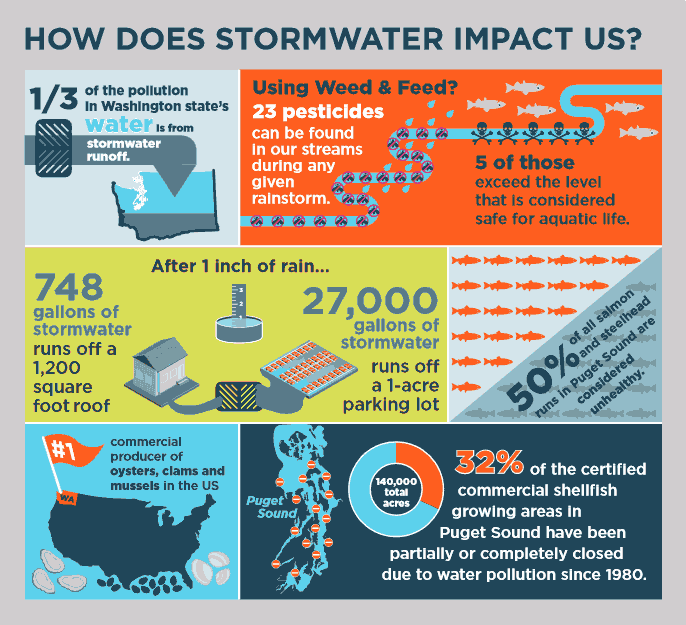Puget Sound is the 2nd largest estuary in the United States (Chesapeake Bay is the largest). The Puget Sound drainage basin is 13,700 square miles and includes 13 U.S. counties plus one in Canada. The basin has three physiographic areas including the Olympic Mountains, the Puget Lowlands, and the Cascade Range (see Figure 1).
If you used the How's My Waterway - Home (epa.gov) tool, you now have some idea of where your watershed sits in the overall drainage basin. One thing you can count on is that water flows downhill! It travels from our neighborhood ditches and stormwater ponds into our local creeks, rivers, and lakes and eventually outfalls to Puget Sound.
 |
Figure 1. Streams and rivers drain three physiographic provinces in the Puget Sound Basin (Black and Silkey, 1998). - from the NAWQA - Water Quality in the Puget Sound Basin.
|
When precipitation falls as rain or snow, it is collected in our stormwater systems and drains into our local waterbodies. Precipitation is generally clean, but as it runs across our roadways and lawns it picks up pollutants like nitrogen, oil, and phosphorus. Common sources include fertilizers, animal waste, and oil leaks from cars. These pollutants create water quality problems. According to the Department of Ecology,
"More than 60 percent of water pollution comes from things like cars leaking oil, fertilizers and pesticides from farms and gardens, failing septic tanks, pet waste, and fuel spills from recreational boating."
The Basics of Good Water Quality
According to the Stormwater Management Manual for Western Washington, the stormwater pollutants of most concern are total suspended solids (sediments), oil and grease, nutrients, pesticides, other organics, pathogens, biochemical oxygen demand, heavy metals, and salts (USEPA, 1995), (Field et al., 1997), and (Strecker et al., 1997).
Urban development as it is done today, harms the environment. This is clearly explained in the Western Washington Stormwater Management Manual in Volume I, Section 1.3, "The Effects of Urbanization." (
Read it here.) It is not very long, and if you are at all interested, I highly recommend you read the entire section. It is eye opening.
The primary thing you can do to help improve water quality is to keep or restore your property to a natural, forested state. More and more I see property owners pave their entire backyard or install covered patios. While this is great for those few occasions you use it, it harms our creeks by increasing runoff and reducing infiltration. Removing natural vegetation reduces the ability of the land to soak up the rain. It turn, this increases runoff and concentrates the pollutants going into our stormwater ponds and natural water bodies, ultimately harming our creeks and the fish who live in them and other critters who depend on them.
Below is a great infographic from King County's Stormwater Services. It puts stormwater quality issues into perspective:
Only Rain Down the Drain
The other thing you can do, is to simply reduce the amount of pollutants you send to the stormwater system. This means using less fertilizer, using commercial car washes, and picking up after your pets. Check out the
Stormwater Pollution Prevention Manual - King County for ideas!
Report a Spill
What should you do if you see a spill?
If you see pollutants like oil or paint, spilled (or dumped) on the road and getting into the stormwater system or our natural waterbodies, please report it! The Department of Ecology (DOE) oversees spill response and prevention through the National Pollutant Discharge Elimination System (NPDES). Cities usually have their own emergency spill response phone lines or online systems. You can use your local jurisdiction's system, or the DOE's online form at
Statewide reporting form ERTS - Washington State Department of Ecology. Any report using this system is also sent to the responsible jurisdiction. Usually someone will follow up with you to better understand the situation and help explain what can be done or even assist to clean up the spill. The sooner you report it, the more we can help.
What Is Your Water Quality Experience?
Have you seen water quality problems where you live? Do you have experience with algae growing in a stormwater pond? Have you thought about what might be causing it? If you have a well-connected neighborhood or an HOA, you might consider trying an experiment! Before next summer, ask your local jurisdiction to give you some information on helping improve water quality in your area and ask your neighbors to commit to following their suggestions. Survey the area to see if anything changes! It might take a year or two, but with a little effort, you just might see improvements in your own environment.
References



No comments:
Post a Comment
Please share your thoughts on my post! Comments with unwanted promotional content will be marked as spam.